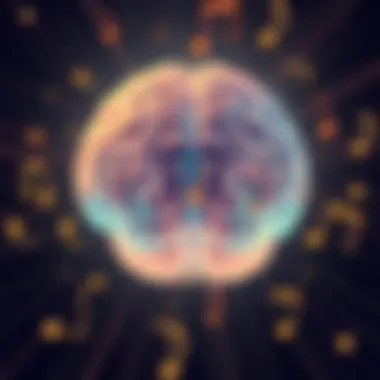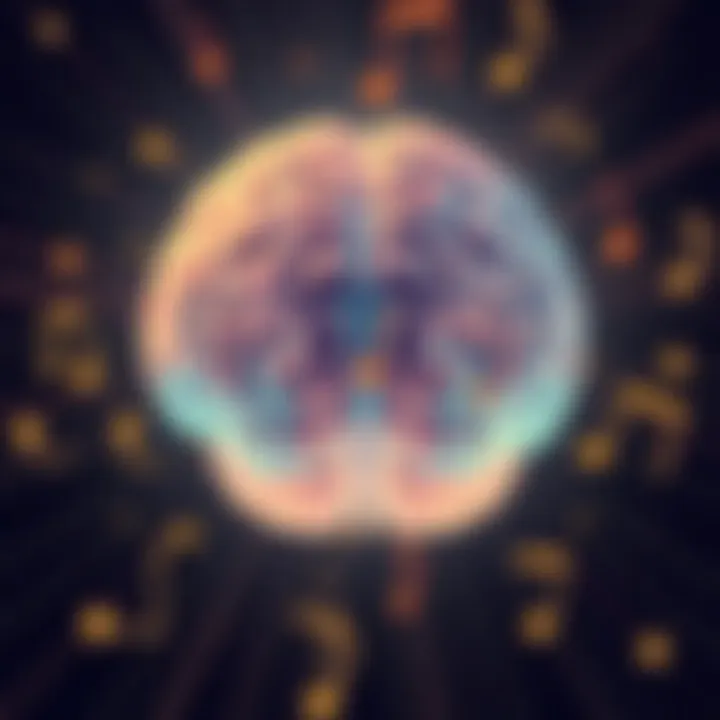The Transformative Effects of Music on Well-Being


Intro
Music has a way of weaving itself into the fabric of our lives. It's more than just sound; it's a powerful catalyst for healing and transformation. From crooning lullabies that soothe infants to rousing anthems that energize crowds, music's reach is vast and deeply ingrained in human experience. This exploration dives into the depths of music's influence on our physical, emotional, and mental well-being, shedding light on how it can be a lifeline in times of distress and a means to enhance joy.
In recent years, there has been a burgeoning body of research confirming what many have long suspected: music can significantly affect our health. Studies have shown how melodies can lower blood pressure, reduce anxiety, and even alleviate pain. However, despite these affirmations, the mechanisms by which music operates on the body and mind remain a complex web that invites further investigation. This piece aims to unpack these elements, revealing the psychological processes that underlie music's healing capabilities.
We'll cover a variety of perspectives, from scientific studies and therapeutic practices to personal stories that illustrate music's transformative power. The applications of music in therapeutic settings, such as in hospitals or mental health facilities, reveal its capacity to improve lives in profound ways. Additionally, the cultural dimensions of music—how different societies harness its healing potential—add another layer that enriches this ongoing dialogue.
Ultimately, this narrative isn't just an academic exploration. It seeks to highlight the everyday ways in which music enhances our quality of life by tapping into its multifaceted role as a healing art form. Let's embark on a journey to uncover the remarkable, life-affirming connections that music engenders.
Understanding Music and its Emotional Resonance
Music is far more than just a collection of notes; it binds together our emotional landscape in ways that are profoundly impactful. Understanding its emotional resonance opens doorways to not only appreciating art but also to realizing its potential as a healing force. The journey through music's emotional corridors helps us connect to our innermost feelings and those of others, facilitating a greater sense of empathy in the human experience.
Music can evoke a spectrum of emotions, whether it’s joy, sadness, nostalgia, or pure exhilaration. This emotional tug-of-war often has deeper implications. There’s a growing acknowledgment that music can play a role in enhancing mental health, reducing symptoms of anxiety and depression, and fostering emotional expression. For instance, finding comfort in a heartfelt ballad during a tough time creates a safe space for reflection and healing, enabling individuals to navigate challenging emotional terrains.
The significance of this understanding can be illustrated by examining two specific elements: the psychological connection to music and the cultural influences that shape our perception of it. These components not only help decode our individual responses but also reveal the universal language of music that transcends barriers.
The Psychological Connection to Music
The psychological mechanisms behind our connection to music delve deeply into the human brain's workings. Research suggests that, as we engage with music, our brains release a cocktail of chemicals, such as dopamine and oxytocin. These neurochemical responses not only elevate mood but also foster social bonding. When people dance together or sing in harmony, they experience a thrilling rush that strengthens communal ties.
Here are a few key points about this psychological bond:
- Emotional release: Music helps channel feelings that are often hard to articulate. Listening to a symphony or a rock anthem allows individuals to process complex emotions and sometimes even leads to catharsis.
- Memory recall: Certain songs can trigger memories from long ago, bringing past experiences back to life. This makes music a powerful tool in therapy settings, where nostalgia can unlock unresolved feelings or traumas.
- Mood regulation: Engaging with specific genres enables individuals to lift their spirits or soothe anxiety. Creating personal playlists for different moods can be an effective way to achieve emotional balance.
Ultimately, understanding the psychological connection reminds us that music serves as a mirror reflecting our inner selves, providing not just entertainment but also a pathway for healing.
Cultural Influences on Musical Perception
Culture shapes one's interaction with music in powerful ways. The musical styles people are exposed to are heavily influenced by their socio-economic backgrounds, traditions, and geographical locations. This leads to diverse interpretations and resonances with music that are unique to each individual or community.
Some elements to consider include:
- Cultural significance: In many cultures, music is integral to rituals, celebrations, and personal milestones. For example, traditional forms, such as Indian classical raga or African drumming, are often associated with specific cultural identities and collective healing practices.
- Generational influences: Each generation tends to define its soundscape, sometimes in reaction to the previous one. This can lead to shifts in societal values expressed through music, influencing how individuals interpret and connect emotionally with the art form.
- Accessibility: The digital age, with its plethora of streaming services and social media platforms, has not only democratized music access but has also contributed to the blending of genres, further enriching the emotional experience. Now, you might hear a crossover of hip-hop and classical, showcasing how personal identity becomes intertwined with musical preference.
By addressing the cultural influences that mold our musical perceptions, we recognize that music is not merely an artistic outlet but a shared experience shaped by diverse narratives and histories.
“Music can change the world because it can change people.” - Bono
Understanding music's emotional resonance requires a comprehensive look at how psychological and cultural components intertwine. This perspective sets the stage for exploring the science behind music healing, providing a foundation for appreciating its transformative power.
The Science Behind Music and Healing
Understanding the intricate relationship between music and healing is no small feat. It’s a realm filled not just with emotional and artistic nuances, but scientific underpinnings that illuminate how melodies and rhythms can influence our very biology. When we talk about the healing powers of music, we’re not merely indulging in abstract concepts; we’re digging into the neurobiological pathways that respond to auditory stimuli. This section dispels myths while showcasing the tangible benefits of music on human well-being.
Neurological Effects of Music
The brain is a remarkable organ, and music is one of its great stimulants. When we listen to our favorite songs, a symphony of neurological responses occurs. Certain areas of the brain light up like a pinball machine. The auditory cortex processes the sounds, while the limbic system stirs emotions. This triggers dopamine release, that feel-good neurotransmitter, making one feel ecstatic or nostalgic depending on the track.
Research has shown that music can impact brain activity in significant ways. Enhanced cognitive abilities such as improved memory and sharper mental acuity can be observed in individuals exposed to music regularly. Not just that, music can mitigate symptoms of various disorders, from anxiety to even chronic illnesses. Listening to calming sounds may slow down heart rates and lower blood pressure, creating an internal environment that nurtures healing. In essence, music engages the brain in profound ways that shape our experiences and emotional states.
Music Therapy: Bridging the Gap
When it comes to integrating music into healing processes, music therapy is a key player. It’s more than just turning up the volume; it’s a structured form of therapy that uses music as a medium for expression and healing. Differently crafted sessions focus on psychological, physical, and social needs of individuals.


A professional music therapist will often meet patients where they are—emotionally and psychologically. This might involve playing instruments, singing, or even songwriting. The therapeutic environment fosters a sense of community, facilitating connections that improve overall healing outcomes. For example, those afflicted by trauma show improved mood stability and reduced anxiety through guided musical activities. It’s this tailored approach that bridges psychological gaps, enhancing emotional resilience.
"Music therapy offers individuals a non-invasive avenue to confront life’s most pressing challenges, often leading to life-altering transformations."
Empirical Studies on Music and Health
To further support the claims of music’s benefits, we must dive into empirical studies that have explored these interactions. Numerous trials—both qualitative and quantitative—have illustrated music’s role as a potent adjunct to conventional medical treatments. For example, a systematic review published in The Journal of Music Therapy found that cancer patients who engaged in music therapy reported reduced pain and nausea levels compared to those who did not.
In outpatient settings, studies have shown that pre-operative patients who listened to soothing tunes experienced lower anxiety levels and required less sedation. It appears that integrating music into healthcare doesn't just facilitate relaxation; it also enhances performance and recovery rates. Whether it’s through palliative care for the elderly or helping children with developmental disorders, music’s healing potential is being increasingly recognized.
Music as a Tool for Emotional Healing
The significance of music in the realm of emotional healing cannot be overstated. When life throws curveballs, many turn to melodies and harmonies as a way to mend emotional wounds. The connection humans have with music often reaches deep into the psyche, offering solace in times of distress and serving as a bridge over troubled water. From the haunting strains of a symphony to the rhythmic beats of contemporary songs, music plays a vital role in our ability to process emotions.
Music’s Role in Coping with Grief
Grief is a universal experience, but coping with it can feel like an uphill battle. Music provides an avenue for expression and a means of navigating this tumultuous emotional landscape. In times of sorrow, individuals often gravitate towards music that resonates with their feelings. For example, a mournful piano piece might align perfectly with their inward turmoil, providing both recognition and relief. Listening to songs that encapsulate one’s grief can act as a cathartic release, allowing for tears and emotions to flow, often making the burden feel lighter.
"Music can change the world because it can change people." – Bono
Moreover, creating music can also serve as an effective tool for self-healing. Individuals sometimes find solace in composing their own pieces, transforming raw emotions into something tangible. This practice can become a reflective journey, facilitating personal growth and helping individuals to understand their grief better.
Addressing Anxiety and Stress through Music
Anxiety and stress can feel suffocating, yet music offers a powerful remedy. The gentle, rhythmic sounds of soft instrumental music can lower cortisol levels and promote relaxation. In a setting as uncomplicated as a quiet room, playing a carefully curated playlist can transport individuals to a place of peace. Several studies indicate that genres like classical and ambient music are particularly effective at alleviating stress by inducing a calm state of mind.
In the modern world, where the fast pace of life wears many down, music therapy has emerged as a popular intervention. Trained therapists utilize specific musical activities to address anxiety, helping clients articulate their feelings and confront their fears in a supportive environment. Additionally, creating playlists tailored to individual stressors can provide immediate relief, empowering individuals to take control over their emotions.
Enhanced Mood and Emotional Regulation
The relationship between music and mood enhancement is a fascinating one. Upbeat tunes, particularly in genres like pop and rock, can uplift mood almost instantaneously. Studies show that listening to happy music releases dopamine—the body’s feel-good chemical. A five-minute song change on a dreary day can do wonders for one's outlook. Embracing the right type of music is essential when aiming for emotional regulation.
Conversely, understanding when to opt for slower, more introspective pieces can provide a valuable space for introspection. Creating a balance allows an individual to navigate between high-energy tracks and calming ballads, essentially mastering the elements of their emotional landscape. This strategic blend supports emotional resilience, enabling individuals to confront challenges head-on while maintaining a sense of equilibrium.
Physical Healing through Sound
The realm of physical healing through sound is a captivating area of exploration, one that interweaves the tangible benefits of music with the intricacies of human physiology. This section is crucial for understanding how sound waves can influence pain perception, aid in rehabilitation, and even alter physiological states. Harnessing music in medical settings offers a promising alternative to conventional approaches.
Impact on Chronic Pain Management
Chronic pain is a persistent adversary for many individuals, often leading to diminished quality of life. Music has emerged as a potent ally in this battle. Research suggests that specific types of music can significantly reduce pain levels. The rhythm and melody can distract patients from their discomfort and foster a sense of relaxation that facilitates pain management.
Moreover, engaging with music has been shown to lower cortisol levels in the body, a hormone linked to stress and, by extension, pain exacerbation. For instance, patients undergoing surgery or recovery often report lower pain levels when exposed to music during their procedures. It’s as if the tunes wash over them, creating a bubble of calm in a storm of discomfort.
"Music can be the armor in the fight against pain, wrapping individuals in a cocoon of soothing sound where hurt feels a little less heavy."
Music’s Effect on Physiological Responses
Music affects the body not just emotionally, but physiologically too. It's fascinating how just listening to certain melodies can influence heart rate, blood pressure, and even respiratory rates. Classical compositions, for instance, have the remarkable ability to precipitate a state of relaxation, lowering heart rates and reducing anxiety.
Additionally, faster-paced music might energize listeners, potentially raising heart rates, which could be beneficial during physical activities or rehabilitation workouts. In this way, music can be seen as both a motivator and a healer, pushing the body towards a more favorable state through its rhythms and vibrations.
Furthermore, research indicates that sound waves can promote healing at a cellular level, stimulating regeneration and repair processes. It’s akin to giving cells a gentle nudge in the right direction, encouraging them to do what they naturally do best – heal the body.
Case Studies on Music in Rehabilitation
Real-world applications of music in rehabilitation demonstrate its incredible potential. One notable case reveals how stroke patients improved their motor skills through rhythmic auditory stimulation. Here, music acted as a cue, helping patients reconnect the dots between their physical actions and the music's tempo, which aided in motor function recovery.


Similarly, in addiction recovery programs, music therapy sessions have proven effective. Patients found solace in songwriting and group singing, creating a supportive community while channeling their emotions into creativity. It recounts stories of struggle and triumph, providing not only a means to express feelings but also helping to foster new neural pathways as they heal.
These cases are just the tip of the iceberg. They highlight the endless possibilities music offers in various rehabilitation contexts, showcasing its role in not just recovery, but also in rediscovering oneself after adversity.
The Role of Diverse Musical Genres in Healing
Music isn't just a bunch of notes thrown together. Its power shifts across genres, each offering a unique pathway to healing. When we tap into various musical styles, we're opening doors to numberless emotional and psychological benefits. A diverse playlist can cater to specific healing needs, presenting different resonances for listeners. The role of musical genres in healing isn't just a side note—it's a crucial part of the broader narrative surrounding music's therapeutic potential.
Classical Music and its Therapeutic Qualities
Classical music holds a special place in the therapeutic landscape, often used in various settings from hospitals to therapy sessions. Its structured arrangements and calming melodies can soothe the mind and spirit. Studies indicate that classical music, particularly those pieces with a slow tempo, can lower heart rates and reduce stress levels.
A notable example is the Mozart Effect, whereby listening to Mozart's compositions reportedly boosts cognitive function. The intricate harmonies and smooth transitions might appeal to a listener's brain in ways that are quite remarkable. In rehabilitation, classical music can promote relaxation during physical therapy, helping patients manage pain while engaging with their recovery process.
"Music speaks what cannot be expressed, soothes the mind and gives it rest, heals the broken heart and makes it whole, flows from heaven to the soul."
The Influence of Folk Traditions
Folk music is steeped in cultural stories, and its healing properties stem from a communal connection to its roots. Unlike classical music's structured formality, folk music thrives on simplicity and relatability. It often tackles life’s struggles, celebrating resilience and hope. When individuals immerse themselves in folk songs from their heritage, it can create a sense of belonging and emotional catharsis.
For example, traditional African drumming often engages the listener and participant in a shared experience of rhythm that can uplift spirits and foster community bonding. This genre transcends mere auditory experience; it becomes a collective journey towards healing, with beats aimed at expressing shared struggles and triumphs. Moreover, participating in these rhythms fosters a deeper connection not only to oneself, but to others—cultural resonance that is hard to overlook.
Contemporary Forms: A New Frontier
In the modern era, contemporary genres like pop, hip-hop, and electronic music are making waves in the realm of healing. These genres often reflect the complexities of modern life, resonating with personal narratives and public sentiments. Music therapy practices now integrate contemporary styles to appeal to younger audiences seeking solace and understanding in their turbulent lives.
Songs laden with personal confessions or rhythmic beats can invoke feelings of empowerment and release. For instance, hip-hop often addresses issues like mental health, functionality in the face of adversity, and self-empowerment. Engaging with these messages can validate listeners' experiences, serving as a healing balm for mental distress.
Additionally, the accessibility of platforms like Spotify or SoundCloud allows users to curate personal playlists tailored to their emotional needs. This capability to navigate diverse genres enhances the therapeutic spectrum available to both practitioners and individuals, seamlessly blending healing with modern technological advancements.
In sum, the variety of genres—be it classical's structured calmness, the cultural essence of folk, or the relatable beats of contemporary music—reveals that each caters uniquely to our emotional landscapes. Understanding these distinctions can lead to more effective therapeutic approaches while reinforcing an important connection between our experiences and the music they inspire.
Integrating Music into Traditional Healthcare Practices
Integrating music into traditional healthcare practices represents a significant advancement in the field of therapy. This fusion illustrates not just an acknowledgment of music's power, but also an opportunity for enhancing patient outcomes by leveraging an intrinsic form of human expression. As practitioners explore the synergy between music and conventional medical interventions, they are discovering a multi-layered approach to patient care that prioritizes healing on emotional, physical, and psychological fronts.
The importance of this integration lies in its multifaceted approach. By blending music with traditional healthcare, medical professionals can address a broader spectrum of ailments and conditions. For instance, hospitals have begun to employ music therapy not only to alleviate anxiety and pain but also to foster a calming atmosphere in clinical settings. This duality amplifies the effectiveness of standard treatments, offering comfort to patients who are often overwhelmed during medical procedures.
With music's capacity to evoke memories and emotions, it serves as a bridge connecting patients to their past experiences. This connection can prove pivotal in recovery, especially in trauma cases or conditions such as Alzheimer’s disease. By revisiting familiar songs, patients may find moments of clarity and comfort that substantially contribute to their emotional recovery.
Furthermore, the concept of healing environments is gaining traction. Studies show that hospitals with music integrated into their atmosphere experience reduced patient stress levels and shorter recovery times. These benefits illustrate the necessity for healthcare systems to embrace, rather than shy away from, an approach that sees the patient holistically rather than solely as a set of symptoms.
Collaborative Approaches in Healthcare
Collaboration between healthcare providers and music therapists fosters an environment where both traditional and alternative therapies can coexist harmoniously. In practice, this might look like a music therapist working alongside physiotherapists to help patients engaged in rehabilitation exercises. Using specific rhythms or tempos during physical therapy can motivate patients, making them more likely to participate and achieve their recovery goals. This active engagement can assist patients in feeling a part of their care process rather than mere recipients of treatments.
In addition, team-based approaches allow for communication between healthcare providers. Regular meetings can provide valuable insights, and healthcare facilities that encourage interdisciplinary dialogues report better patient satisfaction. Each professional brings a unique perspective that when merged can lead to a comprehensive treatment plan.
Key Benefits of Collaborative Approaches:
- Increased patient engagement in treatment
- Holistic view of patient health
- Enhanced communication amongst healthcare providers
- Better patient experiences through personalized care
Patient-Centered Music Interventions
Patient-centered music interventions are all about tailoring the musical experience to individual needs. When patients choose the music they want to listen to during treatment, it often leads to enhanced feelings of control over their environment. This aspect is particularly important in situations where patients feel powerless due to health issues. Just like a well-fitted suit, personalized music tailored to a patient’s taste can make all the difference in a therapeutic setting.
Healthcare providers can implement patient-centered music interventions in various ways. Music can be used in pre-surgery settings to ease anxiety, during surgery for sensory distraction, or in recovery to promote relaxation and healing. The best results often come from involving the patient in the selection process, allowing for a more intimate relationship between the patient and their healing journey.


Specific Strategies Include:
- Preoperative Music Use: Listening to calming music before surgery to lower anxiety levels.
- Healing Playlists: Collaboratively creating playlists that resonate with patients' memories or feelings and using them during hospital stays.
- Live Music Sessions: Inviting local musicians to perform for patients can enhance their spirits and promote community involvement in healthcare.
Ultimately, integrating music into traditional healthcare practices isn’t just a novel idea; it's a thoughtful response to the ongoing need for compassionate care. By recognizing the profound effects music can have on healing, the medical community takes steps toward a more holistic future, one where the well-being of the patient is at the forefront.
“Music can change the world because it can change people.” – Bono
For more information on the healing powers of music, visit Wikipedia, or check out additional studies at Britannica.
Personal Narratives: Experiences of Healing
Personal narratives hold a powerful place in the discussion of how music can act as a healing force. These stories serve as emotional touchstones, illustrating how individuals have transformed their personal struggles into experiences of resilience and recovery through the therapeutic power of music. Each story, distinct as a fingerprint, contributes to a collective understanding of the journey from pain to healing.
Music can often express feelings that words alone cannot capture. For many, personal stories become a validation of their experiences and a means for connection—both with themselves and with others who have faced similar trials. Whether it’s a mother using lullabies to soothe her colicky infant or a war veteran rediscovering peace through melodies, these narratives resonate deeply, resonating the very core of human experience.
Stories from Individuals
In personal accounts, individuals report transformative experiences in which music has played a central role in their healing journey. One poignant example comes from a man named David, who faced severe depression after losing his job. Struggling with intense feelings of isolation and hopelessness, he turned to music, rediscovering an old guitar buried in his attic. Playing instrumental pieces served not only as a form of expression but also as an emotional outlet. Over time, he documented his progress through music and, in doing so, built a community of fellow musicians who offered encouragement and camaraderie. His story is more than just a tale of recovery; it’s a testament to how something as simple as strumming a guitar can weave bonds that promote healing.
"Music can lift the soul from the darkest corners of despair. It reminds us that we are not alone in our struggles."
Another touching narrative comes from a woman named Linda, who battled cancer. During her treatment, she found solace in creating a playlist of songs that reminded her of happier times. Each track on her playlist held memories of family gatherings, road trips, and laughter. Listening to these songs not only fostered a sense of hope but also created a mental space for her to cope with the pain of her illness. In this way, music became her emotional armor against a backdrop of uncertainty.
Practitioner Insights
Healthcare professionals acknowledge the critical importance of listening to these personal narratives. Music therapists often emphasize that understanding individual stories allows them to tailor interventions more effectively. Dr. Jonathan Baker, a certified music therapist, highlights that integrating personal experiences helps create a customized therapeutic approach. He notes, "When I understand a client’s background, I can select musical pieces that resonate with their unique emotional landscape, enhancing the music’s impact on their healing journey."
In addition, engaging with personal stories aids practitioners in recognizing the broader implications of music in health care settings. Music as a therapy tool can bridge gaps that traditional therapies sometimes overlook. Through the lens of personal experiences, practitioners can refine their methods, ensuring they meet the diverse needs of their patients.
As the field evolves, there is increasing interest in documenting and sharing these experiences. Research suggests that personal narratives not only assist in one-on-one therapy but can also foster community healing through group settings. Programs that encourage participants to share their stories often lead to an enriched collective experience, expanding the therapeutic potential of music.
Future Directions in Music and Healing Research
The realm of music and healing is not static; it is a living, breathing field that evolves with societal changes and technological advances. This section explores the importance of investigating future directions for music in healing practices, spotlighting several critical facets and the benefits they herald for both practitioners and patients. As society grapples with increasing mental health challenges, understanding and implementing innovative music therapies becomes paramount for enhancing overall well-being.
Emerging Trends in Music Therapy
In recent years, music therapy has witnessed a significant transformation. The introduction of new methodologies and an increased emphasis on personalized approaches has reshaped the way music is utilized in therapeutic contexts. Therapists are now leaning towards multi-modal frameworks that encompass a wider array of musical styles and practices.
Key Trends in Music Therapy:
- Inclusive Practices: Tailoring interventions to fit diverse communities, including different age groups and cultural backgrounds. This strategy recognizes the importance of keeping music relevant and relatable to those being served.
- Holistic Approaches: Incorporating mind-body techniques, such as mindfulness and movement, in conjunction with music therapy, thereby utilizing a more comprehensive model for healing.
- Collaborative Methods: Facilitating ties between various healthcare professionals to offer integrated treatment. This enhances patient experiences and bridges the gap between mental health and music interventions.
“The evolving landscape of music therapy requires a continuous dialogue between music therapists, researchers, and clients.”
Benefits of Current Trends
Research indicates that personalized and collaborative musical interventions generate higher engagement and more effective outcomes. For instance, patients who participate in community-based music activities report boosts in psychological resilience and social connections. These are not trivial gains—such enhancements can lead to improved emotional wellbeing and even physical health. Moreover, as music therapists adapt to these trends, they are embracing advancements in assessment tools, ensuring that various therapeutic outcomes can be measured reliably over time.
Technological Innovations in Therapeutic Applications
With technology becoming increasingly integrated into our daily lives, its application in music therapy paves the way for groundbreaking improvements in therapeutic practices. Innovations such as mobile applications and virtual reality are beginning to take center stage, offering new dimensions of engagement and personalization in therapeutic interventions.
Noteworthy Innovations:
- Virtual Reality (VR): Tailored VR experiences allow for immersive musical environments that can facilitate relaxation and emotional expression.
- Music Apps: Applications that assist in creating personalized playlists based on a user’s emotional state are emerging. These apps can analyze user input and suggest music properties that correspond to their mood or therapeutic goals.
- Wearable Devices: Stepping into the wearable market, devices can track physiological responses to music, offering real-time feedback. This data can aid therapists in adjusting treatments on the fly to better suit individual needs.
Implications of Technological Integrations
The integration of technology in music therapy shows promise for improving treatment efficacy and accessibility. With remote therapy sessions enabled through video conferencing, even individuals in geographically isolated areas can benefit from specialized therapies. Research is still in its nascent stages, but the potential to expand the reach of music therapy through tech innovations is substantial.
As these advancements unfold, ethical considerations surrounding privacy and data management must remain front and center. However, if approached correctly, the future of music therapy stands to not just keep pace with the pace of technology but lead the charge in holistic healthcare innovatives.







